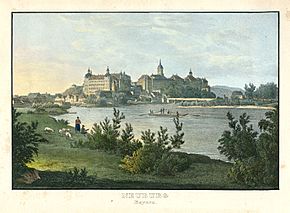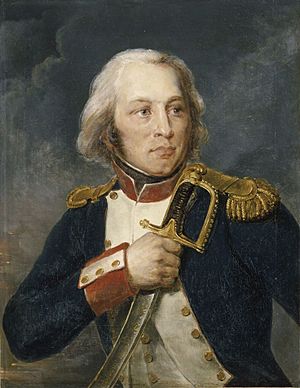Battle of Neuburg (1800) facts for kids
Quick facts for kids Battle of Neuburg |
|||||||
|---|---|---|---|---|---|---|---|
| Part of the War of the Second Coalition | |||||||
 Control of Neuburg, situated on the southern shore of the Danube River, represented a strategic objective for both the French and the Habsburgs. |
|||||||
|
|||||||
| Belligerents | |||||||
| Commanders and leaders | |||||||
| Claude Lecourbe | Pál Kray | ||||||
| Strength | |||||||
| 11,000 | 8,000 | ||||||
| Casualties and losses | |||||||
| approximately 800 wounded or killed, 200 captured | 700 dead or wounded and 600 captured | ||||||
The Battle of Neuburg happened on June 27, 1800. It took place in Bavaria, a region in southern Germany. The battle was fought on the southern bank of the Danube river, near the town of Neuburg an der Donau. This area was important because it was between the cities of Ingolstadt and Donauwörth.
This battle was part of a bigger conflict called the War of the Second Coalition (1798–1802). This war was fought between Revolutionary France and several European monarchies. These included Britain, Austria, Russia, the Ottoman Empire (Turkey), Portugal, and Naples.
By 1800, France, led by Napoleon, was winning many battles. French victories in Germany helped them move closer to Vienna, the capital of Austria. The Battle of Neuburg was one of the last big fights in this area before a temporary peace was signed.
Contents
Why the Battle of Neuburg Happened
In 1799, France wanted to make Austria agree to peace terms. They planned to invade Austria through northern Italy and southern Germany. The French army in southern Germany was led by General Moreau.
Controlling the Danube River
To reach Vienna, the French needed to control the Danube river. This river was a key pathway for moving troops and supplies. The part of the river between Ulm and Neuburg was especially important. It had been a battleground in earlier wars, like the Thirty Years' War.
Controlling cities like Neuburg along the Danube was also a matter of pride. Neuburg was the home of a powerful princely family. Taking it would be a big blow to the Holy Roman Empire and Austria.
Before the Battle: French Advances
Before Neuburg, the French had already won several battles in southern Germany. They captured Stockach, Meßkirch, and Biberach. After these losses, the Austrian commander, Pál Kray, moved his main army to the strong fortress at Ulm.
However, Kray left smaller groups of soldiers to guard important river crossings on the Danube. These crossings were at Höchstädt, Blindheim, Donauwörth, and Neuburg.
Instead of attacking Ulm directly, the French general Moreau sent his troops to capture these smaller crossings. General Claude Lecourbe led this attack. His forces took control of Landsberg and Augsburg.
The French then moved towards Höchstädt. After a tough fight on June 19, 1800, the French won the Battle of Höchstädt. They captured about 2,000 Austrian and Württemberg soldiers. This victory gave the French control of the Danube crossings between Ulm and Donauwörth. Kray had to leave Ulm and move further down the river. The next target for the French was Neuburg.
Who Fought at Neuburg
French Forces
The French army was led by General Claude Lecourbe. His forces included about 11,000 soldiers. They were made up of different types of infantry (foot soldiers) and cavalry (horse soldiers).
Some of the units involved were:
- The 6th and 11th Chasseurs (light cavalry)
- The 13th Cavalry
- The 4th Hussars (light cavalry)
- Parts of the 37th, 84th, 109th, 14th, and 46th Infantry Regiments.
- Famous soldier Théophile Corret de la Tour d'Auvergne, known as the "First Grenadier of France," was also present.
Austrian Forces
The Austrian army was commanded by General Pál Kray. They had about 8,000 soldiers.
Their forces included:
- Infantry Regiments Wenkheim #35 and Erbach #42.
- Cavalry Regiments Lothringen #7, Hohenzollern #8, Kinsky #12 (heavy cavalry).
- Dragoon Regiment Latour #11 (mounted infantry).
The Battle of Neuburg
On June 26, 1800, the French army began to move towards Neuburg. General Montrichard's division marched directly towards Neuburg. General Gudin's division moved south to Pöttmes.
Montrichard's troops easily entered the outer parts of Neuburg. However, the Austrian forces, including those led by Prince Heinrich XV of Reuss-Plauen, came out to defend the city. The Austrians were not fully ready for battle, which allowed the French to get very close to the city.
The French 37th and 84th Regiments quickly took control of the high ground at Oberhausen. By early afternoon, the Austrians had recaptured the village of Niederhausen. But the village of Unterhausen remained in French hands. It was defended by about 100 French marksmen and parts of the 37th and 109th Regiments.
The main fighting then focused on Unterhausen, a village about 6 kilometers west of Neuburg. French soldiers used bayonet charges to push the Austrians out of a nearby forest. As more French troops arrived, the Austrians fought back. They recaptured the woods, the heights at Oberhausen, and the village of Unterhausen. The Austrians set up many cannons on the surrounding hills.
At 8 PM, after 12 hours of fighting, French companies from the 14th and 46th Regiments attacked Unterhausen from both sides. They also attacked the center of the village. The Austrians thought the French had received huge reinforcements. The French attacked without firing their guns, leading to fierce hand-to-hand combat. During this intense fighting, the commander of the 46th Regiment and the famous soldier Latour D'Auvergne were both killed.
Outside the village, French infantry fought bravely against Austrian cavalry. They managed to hold their ground. The fighting continued until about 10 PM, when the Austrians finally pulled back from Unterhausen. General Lecourbe decided not to chase them because it was already dark.
What Happened Next
The Battle of Neuburg had important results. General Ney set up his headquarters in Neuburg Castle. General Moreau ordered a special tomb to be built where Latour D'Auvergne, the "First Grenadier," had died.
Because of his many losses, Emperor Francis II removed General Pál Kray from command. He replaced him with his 18-year-old brother, Archduke John. To help the young Archduke, the emperor appointed experienced generals to guide him.
The series of French victories, from Stockach to Neuburg, broke Austria's control along the important Danube River. At the same time, French victories in Italy, like the Battle of Marengo, forced the Austrians to retreat there too.
With France threatening Austria from two sides, the Austrians agreed to a ceasefire. Peace talks began, but they were difficult because Austria had an alliance with Britain. Britain joined the talks to support Austria. Napoleon later believed that Austria was just trying to gain time until winter, when it would be harder for armies to move.


